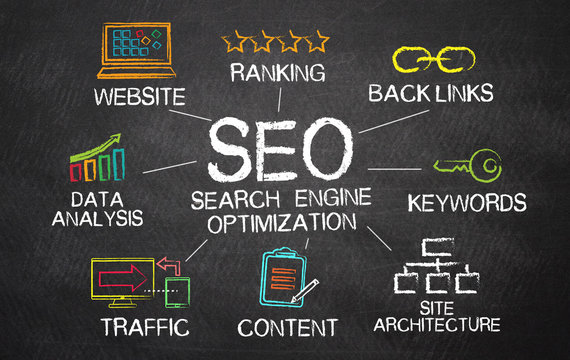Table of Contents
Search Engine Optimization (SEO): The Ultimate Guide for 2025

1. What is SEO?
Search Engine Optimization (SEO) is the process of maximizing the quantity and quality of traffic to your website from organic search engine results. The end goal of SEO is to rank higher in search engine result pages (SERPs) for specific keywords.
In plain language, SEO gets your site seen by people who are looking for the products or services you provide.
2. Why SEO Is A Must In 2025
As we continue to look more and more like a digital-first world, here’s why SEO is indispensable:
- 75% of searchers never go beyond the first page of Google.
- Organic traffic is free and reliable in the long run.
- SEO establishes trust and credibility with users.
- It’s a long-term investment for sustained growth.
- Mobile and voice searches are increasing rapidly.
If you’re not investing in SEO, you’re handing customers to your competitors.
3. How Search Engines Work
Search engines like Google follow three main processes:
- Crawling – Bots scan websites for new content.
- Indexing – The content is stored in a massive database.
- Ranking – Google ranks the content based on relevance, quality, and authority.
The more optimized your site is, the simpler it is for search engines to know and rank your pages.
4. Types of SEO
a) On-Page SEO
Purports to optimize aspects within your website.
Key Elements:
- Proper use of targeted keywords
- Meta title and meta description
- Heading tags (H1, H2, H3)
- Image alt attributes
- URL structure
- Internal linking
- Mobile responsiveness
Optimize titles, meta descriptions, focus keywords, and schema with the RankMath plugin in an easy manner.
b) Off-Page SEO
Requires activities beyond your website to enhance its authority.
Key Tactics:
- Backlink acquisition from authoritative sites
- Guest blogging
- Social signals
- Influencer outreach
- Brand mentions and PR
Quality backlinks = greater domain authority = improved rankings.
c) Technical SEO
Optimizes the underlying structure of your website.
Key Factors:
- Quick page load speed
- Secure connection (HTTPS)
- Mobile-friendly design
- Sitemap and robots.txt
- Structured data/schema markup
- Crawl errors (fix in Google Search Console)
d) Local SEO
Aids your business to rank geo-targeted searches such as “near me”.
Checklist:
- Claim and optimize Google Business Profile
- Incorporate local keywords (e.g., “SEO services in Delhi”)
- Receive reviews from local clients
- NAP consistency (Name, Address, Phone)
5. Keyword Research: The Foundation of SEO
You can’t rank without going for the right keywords.
Steps:
- Find topics that are relevant to your business.
- Utilize tools such as Ubersuggest, Google Keyword Planner, SEMrush.
- Search for long-tail keywords (e.g., “cheap SEO tools for bloggers”).
- Examine keyword difficulty, search volume, and intent.
- Match keywords to individual pages and blogs.
Pro Tip: Go for keywords with medium difficulty and high intent for quicker wins.
6. SEO Content Strategy
Google ranks valuable, user-first content. Here’s how to build it:
- Use your main keyword in the first 100 words.
- Answer the searcher’s intent clearly and quickly.
- Break content into short paragraphs and subheadings.
- Use bullet points, visuals, and examples.
- Include internal links to other relevant blog posts or pages.
- Keep updating old posts to stay relevant.
Write for humans, but optimize for search engines.
7. Link Building Strategies
Links are votes of confidence in Google’s book.
Proven Strategies:
- Guest blogging
- Broken link building
- Skyscraper method (better content than the competition)
- Directory submissions
- Resource pages
- HARO (Help a Reporter Out)
Quality > Quantity. Stay away from spammy backlinks or link swaps.
8. Mobile SEO & Core Web Vitals
Google employs mobile-first indexing—your mobile site dictates your rank.
Optimize for Mobile:
- Employ responsive design
- Remove pop-up blockers
- Compress images
- Turn on lazy loading
- Use large, readable fonts
Core Web Vitals (2025 Must-Have):
- LCP: Largest Contentful Paint
- FID: First Input Delay
- CLS: Cumulative Layout Shift
Check your site with PageSpeed Insights & Lighthouse.
9. SEO Tools You Need in 2025
Here are some must-use tools every marketer and business:
| Tool | Purpose |
| Google Analytics 4 | Traffic & user insights |
| Google Search Console | Indexing, crawling, keywords |
| RankMath | WordPress SEO plugin |
| SEMrush/Ahrefs | Backlink & competitor analysis |
| Ubersuggest | Keyword research |
| GTmetrix | Page speed |
| Screaming Frog | Site audits |
10. SEO vs. SEM: What’s the Difference?
| Feature | SEO | SEM (Search Engine Marketing) |
| Traffic Type | Organic (Free) | Paid (Ads) |
| Timeframe | Long-term | Short-term (Instant) |
| Cost | Time investment | Budget investment |
| ROI | Increases over time | Immediate but ceases with budget |
Use SEO for long-term growth, SEM for quick results.
11. Common SEO Blunders to Steer Clear
- Not paying heed to mobile optimization
- Overstuffing keywords artificially
- Omitting title tags and meta descriptions
- Failing to use HTTPS
- Failing to repair broken links or redirects
- Thin, copied content
- Not refreshing stale posts
12. SEO Trends in 2025
Get ahead with these revolutionary trends:
- Artificial Intelligence-based SEO tools such as ChatGPT and Surfer SEO
- Voice Search Optimization (e.g., “Hey Google…”)
- Video SEO – YouTube title, tag, and transcript optimization
- Zero-click results (Featured snippets, People Also Ask)
- First-party data and cookie-less tracking
13. RankMath SEO Plugin: Setup and Tips
If you’re using WordPress, RankMath is a must-have.
Why RankMath?
- Real-time content analysis
- Focus keyword integration
- Easy schema markup
- Sitemap & redirection management
- WooCommerce SEO support
Quick Setup Tips:
- Connect to Google Search Console
- Use 1 primary keyword per post
- Enable auto-generated schema
- Monitor redirections and 404 errors
14. Final Words
SEO is no longer a choice—it’s the foundation of any serious online presence. If you’re a small business, a blogger, or an eCommerce brand, a solid SEO strategy will make sure you’re visible, discoverable, and competitive.
Begin with the basics: optimize your pages, build good content, get real backlinks, and monitor your performance regularly.
15. FAQs on SEO
Q1. How long does SEO take to work?
Typically 3–6 months, depending on your niche, competition, and effort.
Q2. Can I perform SEO on my own?
Yes! Using tools such as RankMath and free resources, it is easy for beginners to perform SEO.
Q3. Is SEO a free practice?
You don’t pay search engines, but you spend time or pay experts/agencies.
Q4. Are keywords still relevant in 2025?
Yes, but keep an eye on search intent and natural usage.
Q5. How do I check if my SEO is working?
Monitor organic traffic, keyword positions, CTR, and leads with Google Analytics & Search Console.
Q6. How does Local SEO differ from SEO?
Local SEO ranks within a particular region, usually for brick-and-mortar businesses.
Q7. Can SEO be done without backlinks?
Backlinks are a powerful ranking signal. They are not required but assist immensely.
Q8. Do I need to prioritize mobile SEO?
Definitely! Google prefers mobile sites.
Q9. Is RankMath or Yoast SEO better?
They are both wonderful, but RankMath provides more functionality for free.
Q10. Can I implement AI in SEO?
Yes! AI tools assist with keyword suggestions, content optimization, and technical audits.
Ready to Rank Higher?
At TheNextDigital, we are experts in robust, performance-driven SEO strategies. Be it increasing traffic, ranking higher on Google, or reigning supreme on your niche—we’re here to help.


